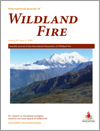International Journal of Wildland Fire
Volume 29
Number 3 2020
Alpine environments are considered the Earth’s third pole and adversely affected by climate change. Himalaya residents often use fire for socioeconomic purposes. Fire in alpine shrublands can increase the availability of valuable herbaceous and woody species used as medicine, in religion and as fodder.
This paper quantifies dead wood dynamics in Australian savannas. Field observations and modelling demonstrate considerable scope for increasing carbon stocks in woody debris through reducing fire frequency. These calculations include standing dead trees, a hitherto unquantified carbon pool that comprises most of the woody debris in these systems.
We measured plant community succession, spanning 16 years, following fire on Wyoming big sagebrush steppe, eastern Oregon. Treatments were burned and unburned sagebrush steppe. Early succession was dominated by native herbaceous perennials, though non-native exotics also increased. It was estimated that cover of sagebrush would return to pre-burn levels in 115 years.
We determine erosion risks across contrasting landforms and variable fire severity, using the Revised Universal Soil Loss Equation (RUSLE), and evaluate whether post-fire water quality impacts can be detected at river monitoring stations located on the coastal plain below the Darling escarpment in south-western Australia.
Field-scale fire experiments were conducted to quantify the effect of wheat crop condition on fire behaviour. Data were used to evaluate existing fire spread models applied operationally to forecast fire propagation in grass and croplands in Australia. These models were shown to adequately predict the rate of fire spread in wheat crops.
Two methods for quantifying a fire’s speed are the cumulative and the interval spread rates. These two metrics were analysed using data from experimental fires conducted at laboratory and field scales. Mean spread rates for the interval method were found to be generally faster than that of the cumulative method.
A method for estimating socioeconomic impacts of satellite observations in the context of supporting wildland fire suppression decisions is discussed. We address asset valuation issues and describe a simulated wildfire decision-making experiment in the setting of the 2011 Las Conchas Fire. Modelling was provided by WRF-SFIRE.
Changes in peak and sustainable aerobic fitness of wildland firefighters were evaluated over a wildland fire season. Individual and group peak aerobic fitness was unchanged. Sustainable aerobic fitness of crew members became more homogeneous, improving for initially less-fit firefighters but decreasing for initially more-fit firefighters. WLFFs lost small amounts of fat and lean body mass over the season.





